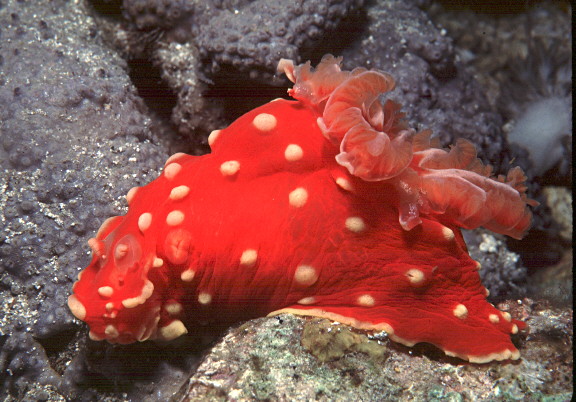
Gymnodoris aurita
Gymnodoris aurita (Gould, 1852)
This huge dorid nudibranch can be spotted from some distance due to its brilliant orange to red body color, highlighted with white to yellow spots, rhinophores, gills and foot margin. Found on shallow reefs from Fiji to the Philippines and Indonesia (Gosliner & Behrens, 1997, Cal Acad. Proc. Vol. 49. No. 9), this species has a firm body reaching over 100 mm in length.
A true example of aposematic (warning) coloration in nudibranchs, this species warns potential predators and antagonists to beware, with its flamboyant color. Close internal examination has revealed a network of densely set glandular tubes under the skin. This network presumably secretes a noxious chemical for defensive purposes. Even with such a sophisticated system of warning signals and chemical warfare, commensal shrimp of the genus Periclimenes, have been observed walking on the mantle of G. aurita (Mark Prein, pers. comm.).
Prior to the confirmation of the identification of this species a small group of Philippine nudibranch enthusiasts referred to the animal as Gymnodoris "rex" due to its similar voracious feeding posture with that of the dinosaur Tyrannosaurus rex. Active nocturnally, Gymnodoris has been observed rising up over its prey in a fashion similar to T. rex attacks seen in the movie Jurassic Park. An opisthobranch predator, it has been observed feeding on tritoniid nudibranchs of the genus Marionia (Mark Prein, pers. comm.).
Gymnodoris aurita is shown as Gymnodoris sp. in Coral Reef Animals of the Indo-Pacific (Gosliner, Behrens & Williams, 1996, species # 607). A similar, but likely undescribed species from Australia, is reported in Wells & Bryce (1993, figure # 98) as Gymnodoris aurita. This distinctive species differs from the original description of G. aurita in having dark maroon rhinophores and gills, while those of G. aurita are the same whitish yellow color as the body tubercles. Also, G. aurita has a wide yellow margin to the foot that is absent in the Wells & Bryce specimen.
Taxonomic information courtesy of:

David W. Behrens
Author:
Pacific Coast Nudibranchs
Send Dave mail at seachalleng@earthlink.net
|
